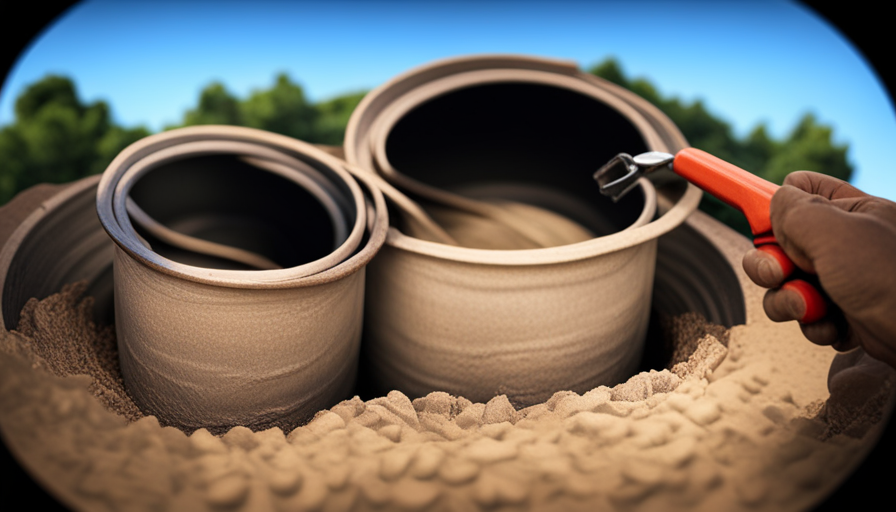Are you fed up with pesky holes and tears in your pop-up camper canvas? Don’t worry! I have the perfect solution for you. Say goodbye to those irritating leaks and hello to a fully repaired canvas that can handle even the most challenging camping trips.
In this article, I will guide you through the step-by-step process of patching your pop-up camper canvas like a pro.
First, we’ll assess the damage and gather all the necessary tools and materials.
Then, we’ll clean the area and cut and prepare the patch.
Whether you choose to apply adhesive or sew the patch, I’ll provide you with detailed instructions.
After allowing the patch to dry or set, we’ll test the patched area to ensure it’s watertight.
Lastly, I’ll share tips on how to clean and maintain your canvas for long-lasting results.
Get ready to impress your camping buddies with your newfound patching skills. Let’s dive in and get your pop-up camper canvas looking as good as new!
Key Takeaways
- Assess the damage and gather necessary tools and materials
- Clean the area and allow the canvas to dry completely before patching
- Position and secure the patch with adhesive or sewing, ensuring a secure bond
- Regularly clean and maintain the canvas to prevent damage and extend its lifespan
Assess the Damage
Take a close look at the pop-up camper canvas to see the extent of the damage and determine where the patches will need to be applied. This step is crucial in assessing the techniques you’ll need to use for repairing the canvas.
Start by examining the canvas thoroughly, paying attention to any tears, holes, or worn-out areas. Look for signs of wear and tear, such as frayed edges or faded colors. It’s important to determine the size and location of the damage, as this will help you determine the appropriate repair options.
Small tears or holes can often be fixed with a simple patch, while larger or more complex damage may require additional steps. Once you’ve assessed the damage, you can proceed to gather the necessary tools and materials for the repair process.
By carefully evaluating the canvas and determining the repair options, you’ll be better prepared for the next step in patching the pop-up camper canvas.
Gather the Necessary Tools and Materials
To gather the necessary tools and materials for patching a pop-up camper canvas, I’ll need a canvas patching kit, a pair of scissors, and either adhesive or sewing supplies.
The canvas patching kit will provide all the necessary materials to effectively repair any tears or holes in the canvas.
The scissors will be used to cut the patch to the desired size, while the adhesive or sewing supplies will be used to secure the patch in place.
Canvas patching kit
Using a canvas patching kit will effortlessly mend your pop-up camper’s canvas, giving you peace of mind for your next adventure. When it comes to canvas patching techniques, finding the right patching materials is crucial. A canvas patching kit typically includes adhesive patches, a patching tool, and instructions for use. These kits are specifically designed to repair small tears or holes in your camper’s canvas, ensuring that it remains durable and waterproof. By following the instructions provided, you can easily apply the patches to the damaged areas and restore the integrity of your camper’s canvas. Once the patches are securely in place, you can confidently continue your outdoor journey. Now, let’s move on to the next step and talk about the importance of having a good pair of scissors for this task.
Scissors
When wielding a trusty pair of scissors, you can effortlessly trim away any unwanted fabric with the precision of a surgeon, ensuring your canvas remains flawless. Here’s how you can effectively cut canvas for patching or repairs:
-
Choose the right scissors: Opt for a pair with sharp, pointed tips for precise cutting.
-
Mark the area: Use a fabric marker or chalk to outline the damaged section before cutting.
-
Begin cutting: Start at one end of the marked area and carefully follow the lines, maintaining a steady hand.
-
Consider alternative repair methods: If the damage is extensive, you might want to explore adhesive patches or sewing supplies as a solution.
With your canvas now neatly trimmed, it’s time to move on to the next step: using adhesive or sewing supplies to patch up the damage.
Adhesive or sewing supplies
Once you’ve expertly trimmed your canvas, it’s time to explore the world of adhesive or sewing supplies to effortlessly repair any damage.
When it comes to patching up your pop-up camper canvas, you have the option of using either adhesive or stitching. Each method has its pros and cons.
Adhesive offers a quick and easy fix. It provides a strong bond and is ideal for smaller tears or holes.
On the other hand, stitching provides a more durable and long-lasting solution. It can withstand the test of time and is better suited for larger repairs.
Consider the size and location of the damage, as well as your personal preference, when deciding between adhesive and stitching.
Once you’ve made your choice, you can move on to the next step of cleaning the area.
Clean the Area
To effectively clean the area, it’s essential to thoroughly remove any dirt or debris from the pop-up camper canvas. This will ensure a smooth and adhesive-friendly surface for patching. Here are some steps to follow:
- Start by using a soft brush or broom to gently sweep away any loose dirt or debris. Be careful not to scrub too hard, as this could damage the canvas.
- Next, use a mild soap and water solution to clean the area. Dip a sponge or cloth into the soapy water and gently scrub the canvas. Make sure to pay extra attention to any areas that are particularly dirty or stained.
- Rinse the canvas thoroughly with clean water to remove any soap residue. It’s important to remove all traces of soap, as it can interfere with the adhesive’s effectiveness.
- Finally, allow the canvas to dry completely before moving on to the next step.
Preparing the surface and choosing the right adhesive are crucial steps in successfully patching a pop-up camper canvas. Once the area is clean and dry, you can proceed to cut and prepare the patch for application.
Cut and Prepare the Patch
After thoroughly cleaning the area, it’s time to move on to the next step in patching up the pop-up camper canvas: cutting and preparing the patch.
This is a crucial step that requires careful attention to detail and precise cutting techniques.
To begin, gather the necessary materials such as a durable patch material that matches the color and texture of the existing canvas. Use a measuring tape to carefully measure the size of the damaged area and add an extra inch on all sides to ensure proper coverage.
Once you have the measurements, use a sharp pair of scissors or a utility knife to cut the patch to the appropriate size. It’s important to cut the patch with clean, straight lines to ensure a seamless repair.
Next, take the time to position the patch over the damaged area and make any necessary adjustments to ensure a perfect fit. Pay attention to the grain or pattern of the canvas and align it accordingly for a seamless appearance.
Now that the patch is cut and prepared, it’s time to move on to the next step: applying the adhesive or sewing the patch. But before we do that, let’s make sure the patch is securely in place and ready for the final steps of the repair process.
Apply the Adhesive or Sew the Patch
Now it’s time to secure the patch in place using either adhesive or by sewing it, ensuring a strong and long-lasting repair. When deciding whether to use adhesive or sewing, it’s important to consider the pros and cons of each method.
Here are some factors to consider when choosing the right patching method:
-
Adhesive:
-
Pros: Adhesive provides a quick and easy way to attach the patch. It requires minimal skill and can be done by anyone.
-
Cons: Adhesive may not be as durable as sewing, especially if the camper canvas is exposed to harsh weather conditions or frequent use. It may also leave a visible residue on the fabric.
-
Sewing:
-
Pros: Sewing offers a more secure and long-lasting repair. It ensures that the patch stays in place even under extreme conditions.
-
Cons: Sewing requires some level of sewing skills and may take more time and effort compared to using adhesive.
When choosing between adhesive and sewing, it’s important to consider the specific needs of your camper canvas and the level of durability required.
Once the patch is securely in place, the next step is to smooth out the patch and ensure a seamless integration with the existing fabric.
Smooth Out the Patch
To smooth out the patch, I press down firmly to ensure a secure bond between the patch and the canvas. This helps to prevent any future lifting or peeling.
I also make sure to smooth out any wrinkles or bubbles that may have formed during the application process, using my hands or a smooth object like a credit card.
Press down firmly to ensure a secure bond
Make sure to press down firmly on the patch to guarantee a secure bond that’ll keep your pop-up camper canvas in perfect condition. Before applying the patch, it’s important to assess the damage and clean the affected area thoroughly.
Once the patch is in place, use your hands to firmly press down on it, ensuring that it adheres securely to the canvas. You can also use a roller or a flat object to apply even pressure across the entire patch.
Pressing down firmly helps to eliminate any air bubbles or wrinkles that may have formed during the patching process. This step is crucial in achieving a seamless repair and preventing any further damage.
Smooth out any wrinkles or bubbles that may appear, making sure the patch is completely flat and secure before moving on to the next step of smoothing out any wrinkles or bubbles.
Smooth out any wrinkles or bubbles
Gently press and smooth any wrinkles or bubbles that may have formed during the patching process, ensuring a flawless and secure bond for your pop-up camper canvas. Smooth out any imperfections with your fingertips, starting from the center and working your way outwards. This will help to distribute the adhesive evenly and prevent any future damage to the patch.
To achieve a long-lasting patch, here are some tips:
-
Make sure the patch is completely dry before folding or storing the camper. Moisture can weaken the adhesive bond and lead to peeling or detachment.
-
Avoid exposing the patch to extreme temperatures, as this can cause the adhesive to break down over time.
-
Regularly inspect the patch for any signs of wear or damage. If you notice any issues, promptly address them to prevent further damage.
By following these tips, you can ensure that your patch will stand the test of time and keep your pop-up camper canvas in excellent condition.
Now, allow the patch to dry or set before moving on to the next step of your camper maintenance routine.
Allow the Patch to Dry or Set
Once your patch is applied, you’ll need to let it dry or set before moving on to the next step. Allowing the patch to cure is crucial for ensuring its proper adhesion and effectiveness. Here are three key things to keep in mind during this crucial waiting period:
-
Time: Depending on the type of patch you used and the specific instructions provided, the drying or setting time may vary. It’s important to carefully read and follow the manufacturer’s guidelines to ensure optimal results. Rushing the process may compromise the patch’s ability to securely bond with the canvas.
-
Environmental conditions: The temperature and humidity levels in your surrounding environment can impact the drying time of the patch. It’s advisable to choose a day with moderate temperature and low humidity to facilitate quicker and more effective drying. Additionally, you should make sure the area is well-ventilated to promote air circulation and aid in the drying process.
-
Checking for proper adhesion: Once the recommended drying or setting time has passed, carefully inspect the patched area. Look for any signs of poor adhesion, such as peeling or lifting edges. If you notice any issues, you may need to reapply the patch or seek further assistance.
After allowing the patch to dry or set, it’s time to move on to the next step: testing the patched area to ensure its durability and effectiveness.
Test the Patched Area
Now that the patch has dried or set, it’s time to give the repaired area a thorough examination, ensuring its durability and effectiveness. Testing techniques are crucial in evaluating the durability of the patch on your pop-up camper canvas.
Start by gently pressing on the patched area to see if it holds up under pressure. Apply a bit of force to simulate real-life conditions and observe if the patch remains intact.
Next, perform a visual inspection. Look closely at the edges of the patch to check if it has adhered securely to the canvas. It should blend in seamlessly without any signs of peeling or detachment. Additionally, run your hands over the patched area to feel for any irregularities or roughness. A smooth and even surface indicates a successful repair.
To further evaluate the durability, consider testing the patch under different weather conditions. If possible, expose your camper to rain or spray it with water to see if the patch remains waterproof. If the repaired area shows any signs of leakage, you may need to reinforce the patch or apply additional waterproofing measures.
By thoroughly testing the patch, you can ensure that it will withstand the rigors of camping.
With the repaired area now evaluated for durability, it’s time to move on to the next section about how to clean and maintain the canvas.
Clean and Maintain the Canvas
To maintain the longevity of my pop-up camper canvas, I regularly clean it to prevent any potential damage. I make sure to remove any dirt, dust, or debris using a soft brush or cloth.
Additionally, I apply a waterproofing spray or sealant to provide an extra layer of protection against the elements.
Regularly clean the canvas to prevent further damage
Make sure you regularly clean the canvas to protect your beloved pop-up camper and keep it looking pristine. Cleaning the canvas not only helps to maintain its appearance, but it also prevents mold growth and extends its lifespan. Here are some important steps to follow:
-
Start by removing any loose dirt or debris from the canvas using a soft brush or vacuum cleaner with a brush attachment.
-
Mix a mild detergent with warm water and use a soft cloth or sponge to gently scrub the canvas. Avoid using harsh chemicals or abrasive materials that could damage the fabric.
-
Rinse thoroughly with clean water and allow the canvas to dry completely before folding or storing.
-
Apply a fabric protectant spray to add an extra layer of protection against stains and UV damage.
Regularly cleaning the canvas will ensure its longevity and prevent any potential damage.
In the next section, we’ll discuss how to apply waterproofing spray or sealant for added protection.
Apply waterproofing spray or sealant for added protection
Applying waterproofing spray or sealant not only protects your beloved pop-up camper’s canvas, but also ensures added protection against moisture and the elements, keeping it looking pristine for years to come. To help you choose the right waterproofing spray or sealant for your pop-up camper canvas, consider the following discussion ideas:
| Waterproofing Spray/Sealant | Pros | Cons |
|---|---|---|
| Silicone-based spray | Provides excellent waterproofing | Can be messy to apply |
| Acrylic-based sealant | Easy to apply and dries quickly | May need to be reapplied frequently |
| Polyurethane spray | Offers long-lasting protection | Can be expensive |
Once you have selected the appropriate product, follow these tips for maintaining and reapplying the waterproofing spray or sealant on your pop-up camper canvas:
- Clean the canvas thoroughly before applying.
- Apply in a well-ventilated area, following the manufacturer’s instructions.
- Allow sufficient drying time before folding or storing the camper.
By taking these steps, you can enjoy your fully patched pop-up camper canvas without worrying about moisture or the elements damaging it.
Enjoy your Fully Patched Pop-up Camper Canvas
Now that you’ve fully patched your pop-up camper canvas, it’s time to start enjoying all the adventures that await! With proper canvas maintenance and alternative patching methods, your pop-up camper will be ready for any outdoor excursion.
To ensure the longevity of your newly patched canvas, it’s important to continue regular maintenance. Regularly inspect the canvas for any signs of wear or damage, and promptly address any issues that arise. This includes checking the seams, zippers, and windows for any potential leaks or tears. By staying proactive with your maintenance routine, you can prevent further damage and extend the lifespan of your canvas.
In addition to patching, applying a waterproofing spray or sealant can provide added protection against the elements. This will help to repel water, prevent mold and mildew growth, and preserve the integrity of the canvas. Be sure to follow the manufacturer’s instructions when applying the waterproofing product, and reapply as necessary to maintain its effectiveness.
With your fully patched pop-up camper canvas and proper maintenance routine in place, you can confidently embark on your camping adventures. Whether it’s a weekend getaway or an extended road trip, your pop-up camper is now ready to provide you with comfort and shelter in the great outdoors.
Frequently Asked Questions
How long does it typically take for the adhesive to dry or set?
The adhesive used for patching the canvas typically takes around 24 to 48 hours to fully dry and set. It’s crucial to follow the manufacturer’s instructions regarding the adhesive’s shelf life, as using expired adhesive can lead to ineffective patching.
To ensure a successful repair, it’s important to avoid common mistakes such as applying too much adhesive, not allowing enough drying time, or neglecting to clean and prepare the surface properly.
Can I use any type of adhesive for patching the canvas, or is there a specific type I should use?
For patching canvas on a pop-up camper, it’s important to use the right adhesive. There are specific types of adhesives that work best for this purpose, such as canvas repair adhesive or outdoor fabric adhesive. These adhesives are designed to provide a strong bond and withstand outdoor conditions. While there may be alternative patching methods available, using the recommended adhesive options will ensure a durable and long-lasting repair.
What is the best way to clean and maintain the canvas after it has been patched?
To clean and maintain a patched pop-up camper canvas, I recommend using the best cleaning products specifically designed for canvas materials. Look for mild, non-abrasive cleaners that are safe for outdoor fabrics. Gently scrub the patched area with a soft brush or cloth, and rinse thoroughly with water.
Allow the canvas to air dry completely before folding or storing. Regularly inspect the canvas for any signs of wear or tear, and promptly patch any new damage to prevent future issues.
Are there any additional steps I should take to ensure a secure patch, such as reinforcing the edges?
To ensure a secure patch on your pop-up camper canvas, it’s advisable to reinforce the edges of the patches. This can be done by applying an additional layer of adhesive or stitching around the edges. By reinforcing the patches in this manner, you can enhance their durability and prevent them from peeling or coming loose over time.
This extra step will provide added security to your patches, ensuring they stay in place and maintain their effectiveness in repairing the canvas.
Can I still fold and store the canvas as usual after it has been patched?
Yes, you can still fold and store the patched canvas as usual. Folding techniques vary depending on the size and type of canvas, but generally, you should fold it neatly and avoid any sharp creases or bends that could damage the patch.
If you’re concerned about the durability of the patch, you can reinforce the edges with fabric glue or stitching. Alternatively, you can explore alternative storage options such as rolling the canvas instead of folding it.
Conclusion
In conclusion, patching up a pop-up camper canvas is a task that can be easily accomplished with the right tools and materials. By following the steps outlined in this article, you can restore your canvas and ensure its longevity.
Interestingly, did you know that approximately 85% of pop-up camper owners experience some sort of canvas damage during their camping adventures? By learning how to patch your canvas, you’ll be well-prepared to tackle any future damages and continue enjoying the great outdoors with your fully patched pop-up camper canvas.



















